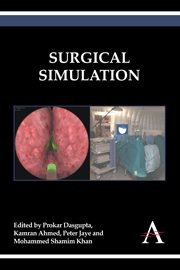Book contents
- Frontmatter
- Contents
- 1 Surgical Simulation: An Overview
- 2 Simulation in Historical Perspective: The History of Medical and Surgical Simulation
- 3 The Role of Animal Models in Surgical Training and Assessment
- 4 Full Procedural Surgical Simulation
- 5 Developing Non-technical Skills
- 6 Learning Curves for Simulators
- 7 Developing a Simulation Programme
- 8 Patient Safety and Simulation
- 9 Psychometrics
- 10 Future of Surgical Simulation
- Author Details
4 - Full Procedural Surgical Simulation
Published online by Cambridge University Press: 05 April 2014
- Frontmatter
- Contents
- 1 Surgical Simulation: An Overview
- 2 Simulation in Historical Perspective: The History of Medical and Surgical Simulation
- 3 The Role of Animal Models in Surgical Training and Assessment
- 4 Full Procedural Surgical Simulation
- 5 Developing Non-technical Skills
- 6 Learning Curves for Simulators
- 7 Developing a Simulation Programme
- 8 Patient Safety and Simulation
- 9 Psychometrics
- 10 Future of Surgical Simulation
- Author Details
Summary
Introduction
Almost half a century ago, the invention of Resusci Anne (Figure 4.1) in 1960 was the first example of a tool for practising a full procedural simulation, but it is only in the past decade that full procedural simulation has rapidly evolved into a useful learning tool for both trainees and experienced doctors. Full procedural simulation refers to the technique of imitating a full operation and, as such, has a number of separate components. The components of a procedure are different from the simple rehearsal of a skill as they take into account both technical and non-technical skills, allowing them to be integrated simultaneously. The invention and validation of distributed simulation has shown how high-fidelity simulators can be made available to wider audiences, improving access to simulation education for all (1).
This shift in paradigm of learning has been brought about by a number of factors. Firstly, in surgery the traditional apprenticeship model is no longer sufficient to develop trainees' skills, as many operations which they historically used as learning cases are no longer performed due to the introduction of minimally invasive techniques and use of video technology via endoscopes and operating microscopes. This has removed many educational opportunities for trainees, leading to a lack of basic procedural operating skills. More universally, the reduction in training hours due to initiatives such as the European Working Time Directive (EWTD) has led to a shortening of the time available for trainees to acquire a full complement of surgical skills (1).
- Type
- Chapter
- Information
- Surgical Simulation , pp. 41 - 50Publisher: Anthem PressPrint publication year: 2014

